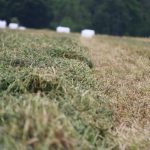Crops benefitted from the warmer temperatures and drier weather conditions earlier in the week and allowed producers to make progress on weed control operations.
Excess moisture conditions in some areas of Manitoba are impacting crop growth, particularly in the lower areas of the fields. Crop yellowing is evident. Wet field conditions also continue to hamper some field operations.
Weed control, and fungicide applications where warranted, will remain a priority for producers as crop development advances. Fungicide applications in winter wheat for leaf disease control and suppression of fusarium head blight has started.
Read Also

Farmer gift idea: How about a weather station?
The 2025 holiday season is looming, and a home weather station might make a great Christmas gift for farmers
Dairy producers continue with first cut haying operations.
Southwest Region
In the Southwest Region, there were good growing conditions early in the week with plenty of moisture and warmer temperatures. Rainfall towards the end of last week and into the weekend brought variable precipitation, with amounts ranging from 20 to 50 mm. The additional moisture is causing moisture stress in low areas of the fields and hindered most field operations.
Seeding is complete in the Southwest Region, except for a few fields that did not get planted before the rain. Most spring cereal crops range in development from five leaf to early flag leaf stage. Many producers are planning to spray fungicide for leaf diseases, if conditions warrant application. Canola is looking good and most fields are in the rosette stage. There are reports of spraying for flea beetles and cutworm in later seeded fields. Corn and sunflowers are emerging well. Soybeans are responding positively to the higher temperatures and good moisture conditions. Most fields range in development from unifoliate to second trifoliate stage. Field peas are looking promising. Some low areas in the fields are showing signs of stress and disease.
Winter cereals are entering the reproductive stages of development with most fall rye fields at heading stage and most winter wheat fields at full flag leaf stage or even some advance fields starting to head. Some fungicide application in winter cereals is reported.
Post-emergent herbicide applications continue with progress estimated at 60 to 70 per cent complete. Some producers are waiting for fields to dry.
Forages advanced over the past week with the recent rainfall. Grass hay is responding well to the moderate temperatures and adequate moisture. Producers have cattle out on pasture, with pastures in good condition. Dugouts are 95 per cent full.
Northwest Region
Temperatures and rainfall amounts were extremely variable throughout the Northwest Region over the past week. Localized areas around Ste. Rose, Laurier and McCreary received up to 75 mm of rainfall, adding to the already wet field conditions. Crops in this area are yellowing due to excessive moisture. Rainfall amounts north of Ste Rose through Dauphin, Roblin and Swan River ranged between 12 and 28 mm. Soil moisture conditions range from adequate in most parts of the region to excessive in localized parts of the Laurier/McCreary area and the Roblin area.
Seeding operations in the Northwest Region are nearing completion. In general, crop emergence is quite uniform. Most crops throughout the region are progressing well with the exception of those crops impacted by excess moisture conditions. As well, some crops in the Swan Valley that were reseeded due to cutworm damage have yet to emerge. Regionally, 70 per cent of the wheat is at the tillering stage of growth while 30 per cent is elongating. Approximately 20 per cent of the canola is emerging, 80 per cent is seedling and 10 per cent is at the rosette stage of growth. Most of the field peas are in the vegetative stage of growth, while approximately 30 per cent of the soybeans are in the vegetative stage.
Herbicide treatments continue as field conditions allow and as crops reach the proper stage for application. There continue to be reports of flea beetle activity in some canola fields in the Swan River Valley, Roblin and The Pas areas but injury caused by this pest has been minimal. As well, there continue to be cases of cutworms at and above threshold levels in canola, field peas and corn crops in the Swan River Valley. Some of those fields required treatment for cutworms and others had to be reseeded. There were also reports of cutworms at economic thresholds requiring treatment in both The Pas and Roblin areas. Diamondback moth monitoring trap populations continue to be highest in The Pas and Swan Valley areas.
Drier areas north of Swan River and south of Roblin welcomed last week’s rain as forage growth will benefit from the rain. Majority of pastures and hay fields in the area are in good to very good condition, with the exception of areas south of Ste. Rose and McCreary. These areas received 76 mm of rain last week made pastures and fields soft, so any additional moisture will make moving around on them a challenge. Grasses are heading out and the most advanced alfalfa fields are showing a few flowers. Haying has begun for dairy producers but last week’s rain made it challenging to put up high quality feed.
Central Region
Rain showers and thunderstorms were widespread throughout the Central Region, along with strong winds. Western areas saw higher accumulations: Pilot Mound 50 mm; Manitou, Somerset, Clearwater 45 mm, Elm Creek 55 mm and south of Carman 45 mm. Most other areas received 18 to 35 mm of precipitation.
Seeding is reported to be essentially complete in the region. Recent emergence has been rapid with warmer temperatures and moisture. Standing water is a concern in some fields, especially in the later seeded crop; the more advanced crops are better able to handle higher rainfall amounts, although stand thinning is evident in those crops as well. Crop yellowing due to excess moisture is evident; good drying conditions are needed, especially for the heavier clays. Crop was damaged in low spots of many fields, and is more evident in the later seeded fields. Some seeding/re-seeding of canola was delayed due to rainfall; some of those fields are still too wet to seed. The last of the edible beans have been seeded, but some fields will likely be reseeded due to excess moisture causing poor stands.
Cereals are growing rapidly, and most fields are tillering. A few of the most advanced fields are close to flag leaf stage. Canola seeding is almost complete; very few fields remain to be seeded or re-seeded. The crop is now emerging rapidly, and earlier seeded fields are reaching the rosette stage and starting to cabbage. Corn is in the V1 to V5 stage; growth is rapid with the recent moisture and warmer temperatures. Soybean seeding is complete. Fields are in the unifoliate to third trifoliate stage, depending on seeding date; there is rapid growth with the recent warmer temperatures. Where emergence is patchy, some targeted re-seeding has taken place. Post-emergent rolling is occurring in some areas. Peas have advanced, and most are beyond staging for Group 2 herbicides. Yellowing is evident where herbicide applications were made out of the recommended leaf staging. Plants are fairly short due to the earlier cool temperatures and dry soil conditions. Those fields that didn’t receive a pre-plant or pre-emergent herbicide application are suffering from significant weed pressure.
Fall rye is headed and flowering; winter wheat is starting to head out. Some fungicide applications will be made this week for fusarium head blight suppression in winter wheat.
Herbicide treatments continue in all crops as field and weather conditions allow, but applications continue to be a challenge due to timing, rapid weed emergence and growth, and field conditions. Fields are soft, and ruts are visible in some of the wettest fields. The majority of cereal crops have received a herbicide application. Although herbicide applications resumed, on the wettest fields there is little chance of applications being made until the end of the week depending on weather conditions.
Diamondback moth numbers to date are generally low to moderate for the region. Some cutworm activity is reported, with some fields requiring treatment of affected areas. Total area affected is minimal. Flea beetle pressure continues to be a concern in a limited amount of later seeded canola fields. No reports of significant disease pressure in crops to date. Some tan spot is noted in spring wheat fields, and stripe rust was reported in winter wheat.
Forages are growing quickly with alfalfa in early flower stage up to 76 cm in height and tame grasses are heading out. First cut dairy quality haying continues; some producers are ensiling, due to the frequent rains. The moisture is generally beneficial to the hay and pasture. Livestock water supply is adequate.
Eastern Region
Rainfall accumulation in the Eastern Region over the last week was variable and ranged from 13 mm to greater than 75 mm. Localized storm cells in the last half of the week resulted in higher rainfall accumulations in some areas, particularly in northern districts. Standing water in fields is very evident in higher rainfall areas and some loss in yield potential is occurring due to excess moisture stress and delayed weed control. Spraying progress was made, particularly during the first half of the week. Producers are concerned with currently not being able to spray and are looking for good drying conditions in the coming week. Topsoil moisture conditions on crop land are rated from adequate to surplus across the Eastern Region with surplus conditions most noted in northern districts.
Seeding is nearly complete in the Eastern Region with very limited unseeded acres left. Some producers have decided to summerfallow or chemfallow the remaining unseeded acres at this point. Winter cereals are heading. Spring cereals are at advanced tillering. Most canola is in rosette. Most soybeans range from the first to third trifoliate leaf stage. Field peas range from 4 to 8 nodes.
First pass herbicide applications are about 75 per cent complete in the Eastern Region. By crop type, applications in spring cereals are about 90 per cent complete, canola 80 per cent, soybeans 70 per cent and field peas 90 per cent complete. First pass corn herbicide applications are done. Some second pass herbicide applications in soybeans have started. Fungicide applications targeted at fusarium head blight suppression in winter wheat are expected to start by the end of this week. Continued concerns about powdery mildew in winter wheat are noted.
Across the region, the majority of hay land is rated in good condition with 25 per cent of pasture land rated excellent, 50 per cent rated good and 25 per cent rated fair. Haying has started on first cut alfalfa and most of what was cut was made into silage. Yields are reported as average. Livestock are on pasture with some pastures demonstrating lush growth after last week’s rainfall. Availability of livestock water is adequate.
Interlake Region
There were scattered showers throughout the Interlake Region over the past week with accumulations ranging from 5 to 15 mm of rainfall. On Thursday evening, Selkirk area received 35 mm. Fields in the Interlake Region are showing signs of excess moisture stress, including yellowing crops or drowned out low spots. Despite the rainfall during the week, warm temperatures and strong winds did dry some fields allowing producers to wrap up seeding or to start spraying. As field conditions dry up in the North Interlake, the remaining acres should be planted soon.
Spraying herbicides are on-going as producers select fields they can travel in without causing too many ruts. Spraying is estimated to be 30 to 40 per cent complete in the Interlake Region. With warm temperatures and an abundance of moisture, crops have rapidly developed in the last week. Winter wheat has started to head and fungicide timing is expected to be closer to the end of the week for fusarium head blight suppression. Spring cereals continue to tiller and some very early seeded wheat has started show signs of flag leaves. Soybeans are in the unifoliate to first trifoliate stage. Canola staging is more scattered as some fields are just starting to emerge and others are much further advanced. Corn stages range from 4 to 6 leaf and sunflowers are in the 2 leaf stage. Forage grass seed fields have started to head out and alfalfa seed fields continue to grow.
Flea beetle pressure in areas of the North Interlake has been high enough that some producers have sprayed. Diamondback and bertha armyworm counts are low.
Cool temperatures and rainfall this past week encouraged hay and pasture development and growth of forages. Alfalfa is in the late bud stage. Pastures are rated in good to excellent condition and are supplying feed in excess of what is normally expected for this time of year. Most cattle are on pasture and there are adequate water supplies.














